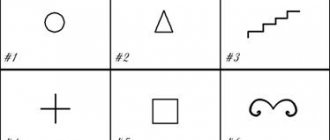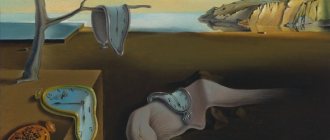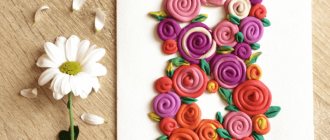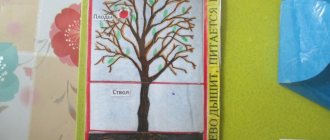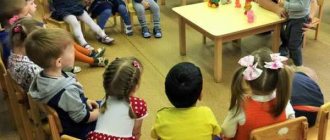The importance of collective work for preschoolers
“The importance of collective work for preschoolers.”
(The purpose of collective classes: to develop the skills and abilities to work together, build communication, develop the habit of mutual assistance, create the basis for the manifestation and formation of socially valuable motives.)
Prepared
teacher at MBDOU kindergarten No. 6 “Vasilyok”.
It is known that children's creativity is a unique phenomenon. Many teachers and psychologists, both domestic and foreign, emphasize the great importance of artistic creativity in the all-round, especially in the aesthetic development of the individual. However, to realize such development, appropriate conditions are required. And if conditions are created for the development of creativity in a group, in kindergarten, children are happy to draw, sculpt, cut out and paste, design various objects, and are ready to spend a lot of time on these activities. What are these conditions? Firstly, this is a positive psychological climate in the children's team; secondly, the use of such types of activities to develop the child’s creative abilities in a group, such as modeling, appliqué, design, and manual labor.
A significant number of children, despite their existing skills and abilities, experience difficulties in creative expression. The main reason is: insufficient level of cognitive interests, lack of activity, initiative, perseverance and ability to achieve a goal.
When solving the problem of developing collective creativity, the teacher should be based on the following principles:
— creative realization of each student as a condition for the development of collective co-creation;
— taking into account the individual characteristics of children when determining their role place in collective interaction;
— managerial direction in staging the process of collective activity;
— the child’s comfort in a group of peers.
Collective works with children are created (starting from early preschool age) in drawing, modeling, appliqué, one type or two or three types in one lesson (modeling and applique, applique and drawing, applique and artistic work).
In joint and independent activities, most often children perform the image individually, each with their own drawing, modeling, appliqué. But children get particular satisfaction from creating common pictures, compositions that combine images of all the children in the group. Such paintings are called collective works. They have a more significant result for children, they cause admiration, truly like in the poem by V. Mayakovsky: “What one cannot do, we will do together.”
Therefore, one of the forms of conducting both joint activities and independent activities in older groups in kindergarten is collective work, the result of which is general paintings, panels, compositions in modeling.
In the process of performing collective work, the moral and aesthetic education of children is carried out, the following skills are developed:
— agree on joint work and its content;
- work together, give in to each other, help, suggest;
- plan your work, determine its sequence, content, composition, additions;
- rejoice at your own and your comrades’ successes in creating work.
All collective work must have a purpose. The teacher leads the children to create a picture together, make decorations for the holiday, decorate a group, a corridor, a hall, make a panel for leisure, for a child’s birthday, decorations for games, performances, posters, a screen book as a gift, illustrate fairy tales, poems, film stills, etc.
While performing group work, children learn to communicate with each other and with adults:
- at the beginning of the year, children work side by side and communicate mainly with the teacher;
- at the second stage, they begin to talk to each other, first about the task, then emphasizing what the neighbor is doing wrong, asserting that they themselves are performing the task correctly;
— gradually, under the guidance of an adult, children begin to communicate with each other: plan, negotiate, ask, give hints, rejoice, praise a friend, etc.
Children turn to an adult when they cannot reach an agreement on their own. Here it is important to suggest how best to negotiate, in which case to give in to each other, if necessary, to teach them to work together, amicably, with pleasure.
In classes, the teacher uses different types of art: fine and decorative, music, dance, literature. Integration makes it possible to show children an artistic image using different means of expression, to see it in their own way, to understand the artist’s creative workshop, to learn to look for ways in creativity, to create their own image.
Basically, group work is carried out with children of the same age. When organizing work, it is important to correctly unite children to perform joint actions, taking into account their behavioral characteristics. Researchers distinguish several types of children depending on their ability to communicate and interact in a friendly manner. These are sociable-friendly, sociable-hostile, unsociable-friendly and unsociable-hostile children. It is necessary to take these features into account when organizing joint activities. Thus, sociable and friendly children can be combined with children belonging to other types. Sociable-hostiles cannot be united with each other and with unsociable-hostiles, and, moreover, it is inappropriate to unite unsociable-hostiles with each other. If there is a need to work in a group of sociable and unsociable-hostile children, it must be “strengthened” by 2-3 sociable-friendly children.
It is easier to organize children to carry out collective work on modeling, applique, design, it is more difficult to draw, but in practice there are various forms of organization that help solve problems in different types of activities. These forms of organizing collective work gradually become more complex depending on the age of the children.
1. Joint-individual
(a child participating in an activity performs part of the work individually, and at the final stage it becomes part of the overall composition).
2. Collective visual activity based on joint
consistent form of organization
(the result of an action performed by one becomes the subject of the activity of another).
3. Collaborative-interacting
(formation of skills to plan, coordinate one’s activities and objectively evaluate the results of collective creative work).
So, children of the younger group each create a separate picture, and at the end they will have a common picture. When all the works are combined together at the end of the lesson, the paintings “Blooming Meadow”, “Forest”, “Chickens on the Grass”, etc. are obtained.
And older children perform a more complex and varied task (“City street” - transport, houses, trees, people, etc.). In order for the children not to interfere with each other when creating collective work, everyone determines the area of their activity, i.e. they agree on who will draw where.
The guidance of a teacher at different stages of the implementation of a plan for collective creative activity has its own characteristics. At the first stage, when planning collective actions, the teacher strives to create a motivational resonance - the emergence in each child of a desire to get involved in a collective activity. It is important to unite children with a common goal, the attractiveness of the future result of the activity, to cause an emotional upsurge, good business excitement. Providing children with a variety of visual materials is attractive to the common cause. So, for example, for appliqué it is advisable to use not only ready-made colored paper, but also clippings from newspapers and magazines, ready-made drawings by children; for modeling, use both dough and plasticine with clay; for drawing, wax and colored pencils, watercolor and gouache, and various building materials.
An effective technique for identifying subgroups of children striving for joint activities can be Children's Interests Day. On this day, children do their favorite things, from which it is clear how many and what kind of children subgroups of children are formed and according to what interests.
The next stage in collective interaction is the distribution of roles for the upcoming activity among the children. In order for participation in a common cause to help each child reveal his best qualities, it is important for the teacher to identify the individual abilities and inclinations of each participant. At the same time, his task is not just to study the child, but to “present” the manifestations of his individual uniqueness and help all children see his best features. For this purpose, it is possible to organize exhibitions of personal achievements, shows of talents and abilities, and for the teacher to focus children’s attention on the actions and activities of a particular child. Identifying the individual characteristics of children allows the teacher to outline the prospects for the development of collective creativity.
Another option for organizing children’s cooperation is that the common goal of the activity is carried out by several subgroups and the final result depends on the quality of the work of each subgroup. Activities of this type evoke a feeling of satisfaction in each participant; the child develops a feeling of usefulness and personal contribution to the common cause, which gives him confidence in his abilities. For example, children are happy to participate in the design of panels on the wall of a group room “Magical Land of Childhood”, “Space”, etc. Dividing at their own request into subgroups, children independently decide what plot will be reflected by their group on a common pictorial field.
The final stages of collective interaction are associated with the achievement, awareness and assessment of the significance of the result obtained. At the same time, the teacher focuses the children’s attention on everyone’s personal contribution to the common cause, emphasizing that without joint efforts, the implementation of the collective plan would be impossible. It is good when the success of collective activities is assessed not only by the children themselves, but also by people whose opinions they value - parents, other educators, children of other groups.
To systematically conduct classes on collective creativity in each kindergarten, a long-term plan is created, topics and materials are selected, and forms of organization are thought out. Thus, collective work can be implemented in several classes. A cycle of classes on one topic provides for a gradual solution of the task. For example, the topic “City Street”: in the first lesson a city is created, in the second lesson on another sheet - transport, at the end of the lesson both sheets are connected. In the third lesson, people perform and complete the city at will (trees, flowers, clouds, sun, etc.)
What hinders the successful development of children's creativity? The most significant drawback in the work of teachers, which hinders the development of children's creativity, is the excessive guardianship of the child, that is, the teacher's intervention in the child's creative process itself, imposing his own idea of work. The next disadvantage that negatively affects the development of children's creativity is the limited number of materials offered to children for drawing, appliqué and sculpting, and children's limited means of depiction. The most negative drawback of work in the development of children's creativity is improper management of children's creativity and the low level of qualifications of the teacher, that is, the teacher lacks the creative potential to solve this issue.
Educators and parents are faced with a task of extreme importance: to ensure that each of those who now goes to kindergarten grows up not only as a conscious member of our society, not only as a healthy and strong person, but also as an initiative, thinking person, capable of a creative approach to any business he takes on. And an active life position can have a basis if a person thinks creatively, if he sees around him an opportunity for improvement.
(Collective work of children of the senior group “Captains” 2014-2015. Panel “Mommy - Spring!”)
(Collective work of children of the preparatory school group “Jolly Guys” 2015-2016. “Bullfinches!”)
(Collective work of children of the preparatory school group “Jolly Guys” 2015-2016. Origami “Fish in an aquarium.”)
Get text
Practical benefits of selling crafts
Creative projects, which are implemented in senior and preparatory groups of kindergarten during classes or independently at home, allow children not only to acquire new skills, but also to consolidate previously acquired skills. This approach makes it possible to facilitate the adaptation period at school. During classes they develop:
- memory;
- attentiveness;
- patience;
- perseverance;
- diligence.
To achieve their goals, educators use a variety of materials in project activities. This:
- working with paper;
- natural materials;
- plasticine;
- cotton wool, plastic.
Crafts are made on different topics. Educators strive to unite the children's team, teaching them to work in teams and individually, organizing exhibitions of work done together with parents.
Summary of GCD in the middle group “Collective broken applique “Kolobok”
Elena Zhernakova
Summary of GCD in the middle group “Collective broken applique “Kolobok”
Goal: developing children’s interest in creative activities through theatrical play based on the Russian folk tale “ Kolobok ”
.
- strengthen the ability to perform cut-out appliqué , creating a fairy-tale hero;
-develop memory, expressiveness of speech;
- develop accuracy and fine motor skills of the fingers;
-induce a feeling of joy from your own work;
- to cultivate interest in theatrical activities.
picture with the image of a bun , a doll in a “Little Red Riding Hood”
, a basket with attributes and masks for staging a fairy tale, yellow paper, napkins, plates for glue.
Crafts made from natural materials
During the school year, preschoolers learn not only about materials and their structure, but also about the world around them. Unusual, beautiful and surprising are those projects that involve natural components.
At the same time, working with such natural materials, children develop:
- fine motor skills;
- spatial thinking;
- Creative skills;
- eye gauge;
- imagination.
At the same time, in the process of work, future schoolchildren learn to find beauty in the world around them. In addition, when working with natural materials, children learn the basics of modeling a holistic image of a hero.
Night in winter
A wide variety of materials are used for winter nights. Therefore, this application is suitable for schoolchildren. For better results, just watch the video and repeat the finished master class. The result will be a nice decoration for your apartment.
At the initial stage, you should decide what will be depicted in the picture. On a winter night there is always a birch tree with a house and a fence, and everything is covered with snow. The desired idea should be sketched on cardboard.
The next step is to prepare a mass of papier-mâché. To do this, napkins are manually crushed and filled with hot water and finally beaten with a blender. Excess moisture is removed by normal squeezing.
PVA glue is added to the finished material until a plastic consistency is formed. The mass is thoroughly mixed and oil is added.
Using plasticine, snowdrifts, logs and branches are formed. The entire drawing is processed with the finished mass. The top of the product is coated with PVA glue. The work must dry well.
The final stage will be painting with gouache. Blue or black would be perfect for it. For snow, you should choose white, and light blue should be used as a shadow. Draw black stripes on white birch. For the house and fence you should choose the desired shade of brown.
Deer
Disposable plates are very good as an applique on the winter theme. You can easily make a Christmas reindeer out of them. The plate is painted brown. Horns are created using handprints.
Cardboard rectangles are suitable for paws. All parts are cut out and attached to each other. Eyes made of beads or paper are glued onto the muzzle.
Winter house
The white sheet is torn into small pieces - this will be snow. This activity is great for developing fingers. Ready-made house templates are printed and cut out. The house is pasted onto the main background, the roof is decorated with cotton wool. Nearby, snowdrifts are created with cotton material.
And at the final stage it is decorated with a previously prepared paper snowball.
Winter ball
The glass ball is a popular souvenir. Using a minimal set of decorative paper, cotton wool and glue, you can create a paper version. Inside the winter ball, using colored paper, it is easy to arrange fairy-tale scenes: houses, Christmas trees, a palace or a snowy landscape.
Note!
New Year's decorations for windows 2022: 150 photos of beautiful templates for do-it-yourself window decorations for the New Year
Hat with mittens
An applique is created from winter accessories. To make the details more realistic, they are decorated with pom-poms made from cotton wool. You can decorate the mittens with felt, bugles or beads.
Bullfinch
Draw the details of the birds on a separate sheet, cut them out and assemble them into the overall picture. For the background, blue paper is selected or a regular sheet is painted blue. Snow is formed using glue and cotton wool.
A bird branch is cut out of brown paper and glued to the main background. There is a bullfinch on a branch. Rowan is created from red balls of paper.
